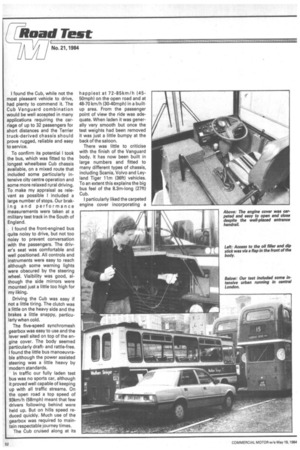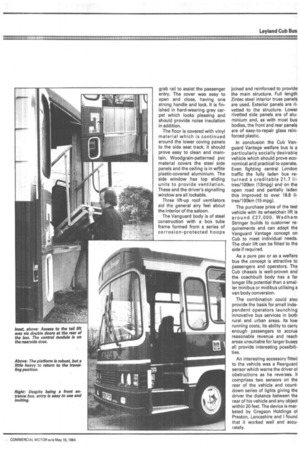A winning combination
Page 69

Page 70

Page 71

If you've noticed an error in this article please click here to report it so we can fix it.
The fusion of a Leyland Cub chassis with a Vanguard Welfare body by Wadham Stringer has produced a highly adaptable bus. Noel Millier assess its suitability for both passenger service and welfare transport
HEALTH AUTHORITIES have transport demands akin to those of the stage carriage bus operator. They need a vehicle capable of reliable and economical stop/start operation while still carrying passengers in comfort. In these days of financial restraint they must above all get value for money in bus operations.
Leyland's Cub passenger service vehicle chassis is an already established provider of this.
Similarly, the Wadham Stringer Vanguard single deck bus body range has found satisfied customers among bus and coach operators, education authorities, the Ministry of Defence and welfare and health authorities.
To see just what a combina tion of the two products can offer I put Wadham Stringer's own demonstrator through its paces. The bus was a Vantage welfare version equipped with 32 bus seats. These were fitted on Shorfast track and could be removed or rearranged by using the key and rubber mallet provided. Securing straps are provided enabling the bus either to carry up to 14 passengers in wheelchairs, or a combination of passengers in wheelchairs and on seats.
Wheelchair fixing is straightforward. Wheelchairs: and wheelchair-bound passengers can be loaded via a Ratcliff electro-hydraulic tail-lift fitted at the rear. Access to the lift is via two outward-opening rear doors. The lift platform can be lowered by releasing a simple, but substantial clip.
Once the tail-lift platform is horizontal it can be lowered or raised by a simple two-button remote control switch held in an aperture on the inside of one of the back doors. The lift can be operated by the driver either from the ground or on the lift while it is being raised. Alternatively there is a master switch on the main instrument panel.
An angled panel is fitted to prevent toe trapping and handrails also enhance the lift's safety.
The platform is three feet wide and nearly four feet deep to allow both a patient or disabled person and an attendant to be raised at the same time.
When the lift is not in use it simply folds back to the vertical and clips into place. It is a substantially-made piece of equipment and it could prove too heavy for an elderly or not particularly strong person to fold back to its travelling position.
The front entrance arrangement on this welfare vehicle was the same as its specification counterpart. A double-leaf power jack-knife door is fitted and this can be operated by the driver. Emergency opening controls are fitted by the interior and exterior of the door. • Despite the vehicle's front engine arrangement, access through the front entrance is easy and a handrail mounted on the engine cover provides plenty of assistance for infirm passengers. The. engine cover itself proved easy to open and close, although this is not necessary to carry out daily vehicle checks. Access to the radiator filler is via a small trap at the front of the engine housing inside the vehicle.
The engine oil dipstick and filler are reached through a flap above the radiator grill from outside. The dipstick itself is particularly long, but easy to reach and the flap is secured by two budget locks.
The Vanguard bus has the feel of a bigger, more sophisticated vehicle and has an airy easy-toclean interior. Although not registered and certified as a psv, the bus is built to psv specifications, so I looked at it as a welfare vehicle as well as a stage carriage or community service vehicle. I found the Cub, while not the most pleasant vehicle to drive, had plenty to commend it. The Cub Vanguard combination would be well accepted in many applications requiring the carriage of up to 32 passengers for short distances and the Terrier truck-derived chassis should prove rugged, reliable and easy to service.
To confirm its potential I took the bus, which was fitted to the longest wheelbase Cub chassis available, on a mixed route that included some particularly intensive city centre operation and some more relaxed rural driving. To make my appraisal as relevant as possible I included a large number of stops. Our braking and performance measurements were taken at a military test track in the South of England.
I found the front-engined bus quite noisy to drive, but not too noisy to prevent conversation with the passengers. The driver's seat was comfortable and well positioned. All controls and instruments were easy to reach although some warning lights were obscured by the steering wheel. Visibility was good, although the side mirrors were mounted just a little too high for my liking.
Driving the Cub was easy if not a little tiring. The clutch was a little on the heavy side and the brakes a little snappy, particularly when cold.
The five-speed synchromesh gearbox was easy to use and the lever well sited on top of the engine cover. The body seemed particularly draftand rattle-free. I found the little bus manoeuvrable although the power assisted steering was a little heavy by modern standards.
In traffic our fully laden test bus was no sports car, although it proved well capable of keeping up with all traffic streams. On the open road a top speed of 93km/h (58mph) meant that few drivers following behind were held up. But on hills speed reduced quickly. Much use of the gearbox was required to maintain respectable journey times.
The Cub cruised along at its happiest at 7 2-85km/h (4550mph) on the open road and at 48-70 km/h (30-40mph) in a builtup area. From the passenger point of view the ride was adequate. When laden it was generally very smooth but once the test weights had been removed it was just a little bumpy at the back of the saloon.
There was little to criticise with the finish of the Vanguard body. It has now been built in large numbers and fitted to many different types of chassis, including Scania, Volvo and Leyland Tiger 11rn (36ft) vehicles. To an extent this explains the big bus feel of the 8.3m-long (27ft) Cub.
I particularly liked the carpeted engine cover incorporating a grab rail to assist the passenger entry. The cover was easy to open and close, having one strong handle and lock. It is finished in hard-wearing grey carpet which looks pleasing and should provide noise insulation in addition.
The floor is covered with vinyl material which is continued around the lower coving panels to the side seat track. It should prove easy to clean and maintain. Woodgrain-patterned pvc material covers the steel side panels and the ceiling is in witite plastic-covered aluminium. The side window has top sliding units to provide ventilation. These and the driver's signalling window are all lockable.
Three lift-up roof ventilators aid the general airy feel about the interior of the saloon.
The Vanguard body is of steel construction with a box tube frame formed from a series of corrosion-protected hoops joined and reinforced to provide the main structure. Full length Zintec steel interior truss panels are used. Exterior panels are rivetted to the structure. Lower rivetted side panels are of aluminium and, as with most bus bodies, the front and rear panels are of easy-to-repair glass reinforced plastic.
In conclusion the Cub Vanguard Vantage welfare bus is a particularly socially desirable vehicle which should prove economical and practical to operate. Even fighting central London traffic the fully laden bus returned a creditable 21.7 litres/100km (13mpg) and on the open road and partially laden this improved to over 18.8 litres/100km (15 mpg).
The purchase price of the test vehicle with its wheelchair lift is around £27,000. Wadham Stringer builds to customer requirements and can adapt the Vanguard Vantage concept on Cub to meet individual needs. The chair lift can be fitted to the side if required.
As a pure psv or as a welfare bus the concept is attractive to passengers and operators. The Cub chassis is well-proven and the coachbuilt body has a far longer life potential than a smaller minibus or midibus utilising a van body conversion.
The combination could also provide the basis for small independent operators launching innovative bus services in both rural and urban areas. Its low running costs, its ability to carry enough passengers to accrue reasonable revenue and reach taireesa.s unsuitable for larger buses all provide interesting possibili An interesting accessory fitted to the vehicle was a Rearguard sensor which warns the driver oi obstructions as he reverses. Ii comprises two sensors on the rear of the vehicle and countdown series of lights giving the driver the distance between the rear of his vehicle and any object within 20 feet. The device is marketed by Gregson Holdings al Preston. Lancashire and I found that it worked well and accurately.
























































































































